Do Optimists Like Vaccines? The Effect of Perceived Vaccine Novelty and Beliefs in the World’s Positivity and Orderliness on the Attitudes toward COVID-19 Vaccinations—The Case of European Young Adults
Abstract
1. Introduction
2. Theoretical Background and Hypothesis Development
2.1. The Role of Beliefs about the World’s Orderliness and Positivity
2.2. The Role of Perceived Vaccine Novelty
3. Method
3.1. Procedure
3.2. Measurements
4. Results
4.1. Testing H1 and H2 (the Role of Beliefs about the World’s Orderliness and Positivity)
4.2. Testing H3 and H4 (the Effects of Perceived Vaccine Novelty on Vaccine Attitudes)
4.3. Testing H5 and H6 (the Moderating Role of Perceived Vaccine Novelty)
5. Discussion
6. Conclusions
6.1. Possible Applications in Vaccine Communication
6.2. Limitations and Future Research Directions
Author Contributions
Funding
Institutional Review Board Statement
Informed Consent Statement
Data Availability Statement
Conflicts of Interest
Appendix A
| Frequency | Percentage | |
|---|---|---|
| Gender | ||
| Women | 225 | 52.9 |
| Men | 193 | 45.4 |
| Other/no response | 7 | 1.6 |
| Age | ||
| under 20 | 25 | 5.9 |
| 20–24 | 340 | 80.0 |
| 25–29 | 43 | 10.1 |
| 30 or more | 17 | 4.0 |
| Education | ||
| High school | 234 | 55.1 |
| University | 191 | 44.9 |
| Occupation | ||
| Only studying | 280 | 65.9 |
| Only working | 68 | 16.0 |
| Working and studying | 77 | 18.1 |
| Previous vaccination against COVID-19 | ||
| Vaccinated | 368 | 86.6 |
| Unvaccinated | 47 | 11.1 |
| No response | 10 | 2.4 |
| Country of residence | ||
| Belarus | 7 | 1.6 |
| Belgium | 4 | 0.9 |
| Czechia | 2 | 0.5 |
| Denmark | 2 | 0.5 |
| France | 7 | 1.6 |
| Georgia | 16 | 3.8 |
| Germany | 84 | 19.8 |
| Greece | 12 | 2.8 |
| Ireland | 2 | 0.5 |
| Italy | 55 | 12.9 |
| Lithuania | 1 | 0.2 |
| Poland | 91 | 21.4 |
| Portugal | 56 | 13.2 |
| Russia | 1 | 0.2 |
| Spain | 68 | 16.0 |
| Switzerland | 4 | 0.9 |
| Netherlands | 5 | 1.2 |
| United Kingdom | 4 | 0.9 |
| Ukraine | 1 | 0.2 |
| No response | 3 | 0.7 |
References
- Abbas, K.M.; Kang, G.J.; Chen, D.; Werre, S.R.; Marathe, A. Demographics, perceptions, and socioeconomic factors affecting influenza vaccination among adults in the United States. PeerJ 2018, 6, e5171. [Google Scholar] [CrossRef]
- Hwang, J. Health information sources and the influenza vaccination: The mediating roles of perceived vaccine efficacy and safety. J. Health Commun. 2020, 25, 727–735. [Google Scholar] [CrossRef] [PubMed]
- Hopfer, S. Effects of a narrative HPV vaccination intervention aimed at reaching college women: A randomized controlled trial. Prev. Sci. 2012, 13, 173–182. [Google Scholar] [CrossRef] [PubMed]
- Cerda, A.A.; García, L.Y. Willingness to Pay for a COVID-19 Vaccine. Appl. Health Econ. Health Policy 2021, 19, 343–351. [Google Scholar] [CrossRef] [PubMed]
- Lacey, R.; Kennett-Hensel, P.A.; Manolis, C. Is corporate social responsibility a motivator or hygiene factor? Insights into its bivalent nature. J. Acad. Mark. Sci. 2015, 43, 315–332. [Google Scholar] [CrossRef]
- ECDC. European Centre for Disease Prevention and Control. COVID-19 Vaccine Tracker. 2021. Available online: https://vaccinetracker.ecdc.europa.eu/public/extensions/COVID-19/vaccine-tracker.html#uptake-tab (accessed on 26 February 2022).
- Franzen, A.; Wöhner, F. Coronavirus risk perception and compliance with social distancing measures in a sample of young adults: Evidence from Switzerland. PLoS ONE 2021, 16, e0247447. [Google Scholar] [CrossRef]
- Rosi, A.; van Vugt, F.T.; Lecce, S.; Ceccato, I.; Vallarino, M.; Rapisarda, F.; Vecchi, T.; Cavallini, E. Risk Perception in a Real-World Situation (COVID-19): How It Changes From 18 to 87 Years Old. Front. Psychol. 2021, 12, 646558. [Google Scholar] [CrossRef]
- Küçükali, H.; Ataç, Ö.; Palteki, A.S.; Tokaç, A.Z.; Hayran, O. Vaccine Hesitancy and Anti-Vaccination Attitudes during the Start of COVID-19 Vaccination Program: A Content Analysis on Twitter Data. Vaccines 2022, 10, 161. [Google Scholar] [CrossRef]
- Maciuszek, J.; Polak, M.; Stasiuk, K. Declared Intention (Not) to Be Vaccinated against COVID-19, and Actual Behavior—The Longitudinal Study in the Polish Sample. Vaccines 2022, 10, 147. [Google Scholar] [CrossRef]
- Baumgaertner, B.; Carlisle, J.E.; Justwan, F. The influence of political ideology and trust on willingness to vaccinate. PLoS ONE 2018, 13, e0191728. [Google Scholar] [CrossRef]
- Luyten, J.; Desmet, P.; Dorgali, V.; Hens, N.; Beutels, P. Kicking against the pricks: Vaccine sceptics have a different social orientation. Eur. J. Public Health 2013, 24, 310–314. [Google Scholar] [CrossRef] [PubMed][Green Version]
- Luyten, J.; Dorgali, V.; Hens, N.; Beutels, P. Public preferences over efficiency, equity and autonomy in vaccination policy: An empirical study. Soc. Sci. Med. 2013, 77, 84–89. [Google Scholar] [CrossRef]
- Pennycook, G.; McPhetres, J.; Bago, B.; Rand, D.G. Beliefs about COVID-19 in Canada, the UK, and the USA: A novel test of political polarization and motivated reasoning. Personal. Soc. Psychol. Bull. 2021, 1–16. [Google Scholar] [CrossRef]
- Sylvester, S.M. COVID-19 and Motivated Reasoning: The Influence of Knowledge on COVID-Related Policy and Health Behavior. Soc. Sci. Q. 2021, 102, 2341–2359. [Google Scholar] [CrossRef] [PubMed]
- Trzebiński, J.; Potocka, A.; Trzebiński, W.; Krzysztoń, M. Willingness to Vaccinate against COVID-19: The Role of Assumptions on the World’s Orderliness and Positivity. J. Loss Trauma 2021, 26, 697–713. [Google Scholar] [CrossRef]
- Erikson, E.H. The Life Cycle Completed; W.W. Norton & Company: New York, NY, USA, 1982. [Google Scholar]
- Trzebiński, J.; Zięba, M. Basic hope as a worldview: An outline of a concept. Pol. Psychol. Bull. 2004, 35, 173–182. [Google Scholar]
- Trzebiński, J.; Zięba, M. Basic Trust and Posstraumatic Growth in Oncology Patients. J. Loss Trauma 2013, 18, 195–209. [Google Scholar] [CrossRef]
- Janoff-Bulman, R. Shattered Assumptions: Towards a New Psychology of Trauma; The Free Press: New York, NY, USA, 1992; ISBN 9780029160152. [Google Scholar]
- Boerner, F.; Keelan, J.; Winton, L.; Jardine, C.; Driedger, S.M. Understanding the interplay of factors informing vaccination behavior in three Canadian provinces. Hum. Vaccines Immunother. 2013, 9, 1477–1484. [Google Scholar] [CrossRef]
- Samoff, E.; Dunn, A.; VanDevanter, N.; Blank, S.; Weisfuse, I.B. Predictors of acceptance of hepatitis B vaccination in an urban sexually transmitted diseases clinic. Sex. Transm. Dis. 2004, 31, 415–420. [Google Scholar] [CrossRef]
- Sherman, S.M.; Smith, L.E.; Sim, J.; Amlôt, R.; Cutts, M.; Dasch, H.; Sevdalis, N. COVID-19 vaccination intention in the UK: Results from the COVID-19 vaccination acceptability study (CoVAccS), a nationally representative cross-sectional survey. Hum. Vaccines Immunother. 2021, 17, 1612–1621. [Google Scholar] [CrossRef]
- Ye, X.; Ye, W.; Yu, J.; Gao, Y.; Ren, Z.; Chen, L.; Song, P. Factors Associated with the Acceptance and Willingness of COVID-19 Vaccination among Chinese Healthcare Workers. MedRxiv 2021. Available online: https://pesquisa.bvsalud.org/global-literature-on-novel-coronavirus-2019-ncov/resource/pt/ppmedrxiv-21257094 (accessed on 26 February 2022).
- Ainsworth, M.D.S.; Bowlby, J. An Ethological Approach to Personality Development. Am. Psychol. 1991, 46, 333–341. [Google Scholar] [CrossRef]
- Bowlby, J. Attachment. Attachment and Loss, 2nd ed.; Basic Books: New York, NY, USA, 1999; Volume 1, ISBN 0-465-00543-8. [Google Scholar]
- Bretherton, I. The origins of attachment theory: John Bowlby and Mary Ainsworth. Dev. Psychol. 1992, 28, 759–775. [Google Scholar] [CrossRef]
- Abrams, D.; Hogg, M.A.; Marques, J.M. (Eds.) The Social Psychology of Inclusion and Exclusion; Psychology Press: New York, NY, USA, 2005. [Google Scholar]
- Franklin, K.; Janoff-Bulmann, R.; Roberts, J. Long-Term Impact of Parental Divorce on Optimism and Trust: Changes in General Assumptions or Narrow Beliefs? J. Personal. Soc. Psychol. 1990, 59, 743–755. [Google Scholar] [CrossRef]
- Durkheim, E. Suicide, a Study in Sociology; Routledge & K. Paul: London, UK, 1952. [Google Scholar]
- Griskevicius, V.; Tybur, J.M.; Delton, A.W.; Robertson, T.E. The influence of mortality and socioeconomic status on risk and delayed rewards: A life history theory approach. J. Personal. Soc. Psychol. 2011, 100, 1015–1026. [Google Scholar] [CrossRef] [PubMed]
- Worthman, C.; Kuzara, C. Life history and the early origins of health differentials. Am. J. Hum. Biol. 2005, 17, 95–112. [Google Scholar] [CrossRef]
- Seligman, M.E.P. Learned Optimism: How to Change Your Mind and Your Life; Vintage Books: New York, NY, USA, 2006. [Google Scholar]
- Snyder, C.R.; Ilardi, S.; Michael, S.T.; Cheavens, J. Hope Theory: Updating a Common Process for Psychological Change. In Handbook of Psychological Change: Psychotherapy Processes & Practices for the 21st Century; Snyder, C.R., Ingram, R.E., Eds.; John Wiley & Sons: Hoboken, NJ, USA, 2000; pp. 128–153. [Google Scholar]
- Snyder, C.R.; Sympson, S.; Michael, S.T.; Cheavens, J. Optimism and Hope Constructs: Variants on a Positive Expectancy Theme. In Optimism and Pessimism: Implications for Theory, Research, and Practice; Chang, E.C., Ed.; American Psychological Association: Washington, DC, USA, 2001; pp. 101–125. [Google Scholar]
- Zięba, M.; Surawska, M.; Zalewska, A.M. Relationships between personality traits, general self-efficacy, self-esteem, subjective well-being, and entrepreneurial activity. Pol. Psychol. Bull. 2018, 49, 131–140. [Google Scholar]
- Fazal-e-Hasan, S.M.; Ahmadi, H.; Kelly, L.; Lings, I.N. The role of brand innovativeness and customer hope in developing online repurchase intentions. J. Brand Manag. 2019, 26, 85–98. [Google Scholar] [CrossRef]
- MacInnis, D.J.; Chun, H.E. Understanding hope and its implications for consumer behavior: I hope, therefore I consume. Found. Trends® Mark. 2006, 1, 97–188. [Google Scholar] [CrossRef]
- Wilson, A.E.; Darke, P.R. The optimistic trust effect: Use of belief in a just world to cope with decision-generated threat. J. Consum. Res. 2012, 39, 615–628. [Google Scholar] [CrossRef]
- Eklund, A.A.; Helmefalk, M. Congruency or incongruency: A theoretical framework and opportunities for future research avenues. J. Prod. Brand Manag. 2021. [Google Scholar] [CrossRef]
- Jansson-Boyd, C.V. Perception and consumption: Touch, multisensory integration and congruency. In Routledge International Handbook of Consumer Psychology; Jansson-Boyd, C.V., Zawisza, M.J., Eds.; Routledge: New York, NY, USA, 2017. [Google Scholar]
- Yoon, H.J. Understanding schema incongruity as a process in advertising: Review and future recommendations. J. Mark. Commun. 2013, 19, 360–376. [Google Scholar] [CrossRef]
- Wansink, B.; Ray, M.L. Advertising strategies to increase usage frequency. J. Mark. 1996, 60, 31–46. [Google Scholar] [CrossRef]
- Doherty, W.J. Cognitive processes in intimate conflict: I. Extending attribution theory. Am. J. Fam. Ther. 1981, 9, 3–13. [Google Scholar] [CrossRef]
- Betsch, C.; Schmid, P.; Heinemeier, D.; Korn, L.; Holtmann, C.; Böhm, R. Beyond confidence: Development of a measure assessing the 5C psychological antecedents of vaccination. PLoS ONE 2018, 13, e0208601. [Google Scholar] [CrossRef] [PubMed]
- Betsch, C.; Habersaat, K.B.; Deshevoi, S.; Heinemeier, D.; Briko, N.; Kostenko, N.; Sivelä, J. Sample study protocol for adapting and translating the 5C scale to assess the psychological antecedents of vaccination. BMJ Open 2020, 10, e034869. [Google Scholar] [CrossRef]
- Dorman, C.; Perera, A.; Condon, C.; Chau, C.; Qian, J.; Kalk, K.; DiazDeleon, D. Factors Associated with Willingness to be Vaccinated Against COVID-19 in a Large Convenience Sample. J. Community Health 2021, 1–7, 1013–1019. [Google Scholar] [CrossRef] [PubMed]
- Ajzen, I.; Fishbein, M. The influence of attitudes on behavior. In The Handbook of Attitudes; Albarracín, D., Johnson, B.T., Zanna, M.P., Eds.; Lawrence Erlbaum Associates Publishers: Mahwah, NJ, USA, 2005; pp. 173–221. [Google Scholar]
- Rindova, V.P.; Petkova, A.P. When is a new thing a good thing? Technological change, product form design, and perceptions of value for product innovations. Organ. Sci. 2007, 18, 217–232. [Google Scholar] [CrossRef]
- Bhatt, S.; Lee, J.; Deutsch, J.; Ayaz, H.; Fulton, B.; Suri, R. From food waste to value-added surplus products (VASP): Consumer acceptance of a novel food product category. J. Consum. Behav. 2018, 17, 57–63. [Google Scholar] [CrossRef]
- Liu, F.; Zhu, Z.; Chen, H.A.; Li, X. Beauty in the eyes of its beholders: Effects of design novelty on consumer preference. J. Retail. Consum. Serv. 2020, 53, 101969. [Google Scholar] [CrossRef]
- Mugge, R.; Schoormans, J.P. Product design and apparent usability. The influence of novelty in product appearance. Appl. Ergon. 2012, 43, 1081–1088. [Google Scholar] [CrossRef]
- Park, C.W.; Lessig, V.P. Familiarity and its impact on consumer decision biases and heuristics. J. Consum. Res. 1981, 8, 223–230. [Google Scholar] [CrossRef]
- Hwang, J.; Lin, T.N. Effects of food neophobia, familiarity, and nutrition information on consumer acceptance of Asian menu items. J. Hosp. Mark. Manag. 2010, 19, 171–187. [Google Scholar] [CrossRef]
- Glaser, M.; Reisinger, H. Don’t Lose Your Product in Story Translation: How Product–Story Link in Narrative Advertisements Increases Persuasion. J. Advert. 2021, 1–18. [Google Scholar] [CrossRef]
- Duncan, C.P.; Nelson, J.E. Effects of humor in a radio advertising experiment. J. Advert. 1985, 14, 33–64. [Google Scholar] [CrossRef]
- ECDC. European Centre for Disease Prevention and Control. COVID-19 Situation Dashboard. 2021. Available online: https://qap.ecdc.europa.eu/public/extensions/COVID-19/COVID-19.html#global-overview-tab (accessed on 26 February 2022).
- Feldman, J.M.; Lynch, J.G. Self-generated validity and other effects of measurement on belief, attitude, intention, and behavior. J. Appl. Psychol. 1988, 73, 421. [Google Scholar] [CrossRef]
- Lunardo, R.; Rickard, B. How do consumers respond to fun wine labels? Br. Food J. 2020, 122, 2603–2619. [Google Scholar] [CrossRef]
- Ferguson, E.; Cox, T. Exploratory factor analysis: A users’ guide. Int. J. Sel. Assess. 1993, 1, 84–94. [Google Scholar] [CrossRef]
- O’Quin, K.; Besemer, S.P. The development, reliability, and validity of the revised creative product semantic scale. Creat. Res. J. 1989, 2, 267–278. [Google Scholar] [CrossRef]
- Trzebiński, J.; Cabański, M.; Czarnecka, J.Z. Reaction to the COVID-19 pandemic: The influence of meaning in life, life satisfaction, and assumptions on world orderliness and positivity. J. Loss Trauma 2020, 25, 544–557. [Google Scholar] [CrossRef]
- Fuller, C.M.; Simmering, M.J.; Atinc, G.; Atinc, Y.; Babin, B.J. Common methods variance detection in business research. J. Bus. Res. 2016, 69, 3192–3198. [Google Scholar] [CrossRef]
- Hayes, A.F. Introduction to Mediation, Moderation, and Conditional Process Analysis: A Regression-Based Approach; Guilford Publications: New York, NY, USA, 2018. [Google Scholar]
- Hayes, A.F.; Montoya, A.K.; Rockwood, N.J. The analysis of mechanisms and their contingencies: PROCESS versus structural equation modeling. Australas. Mark. J. 2017, 25, 76–81. [Google Scholar] [CrossRef]
- Larson, H.; de Figueiredo, A.; Karafillakis, E.; Rawal, M. State of Vaccine Confidence in the EU 2018; Publications Office of the European Union: Luxembourg, 2018; Volume 10, p. 241099. [Google Scholar]


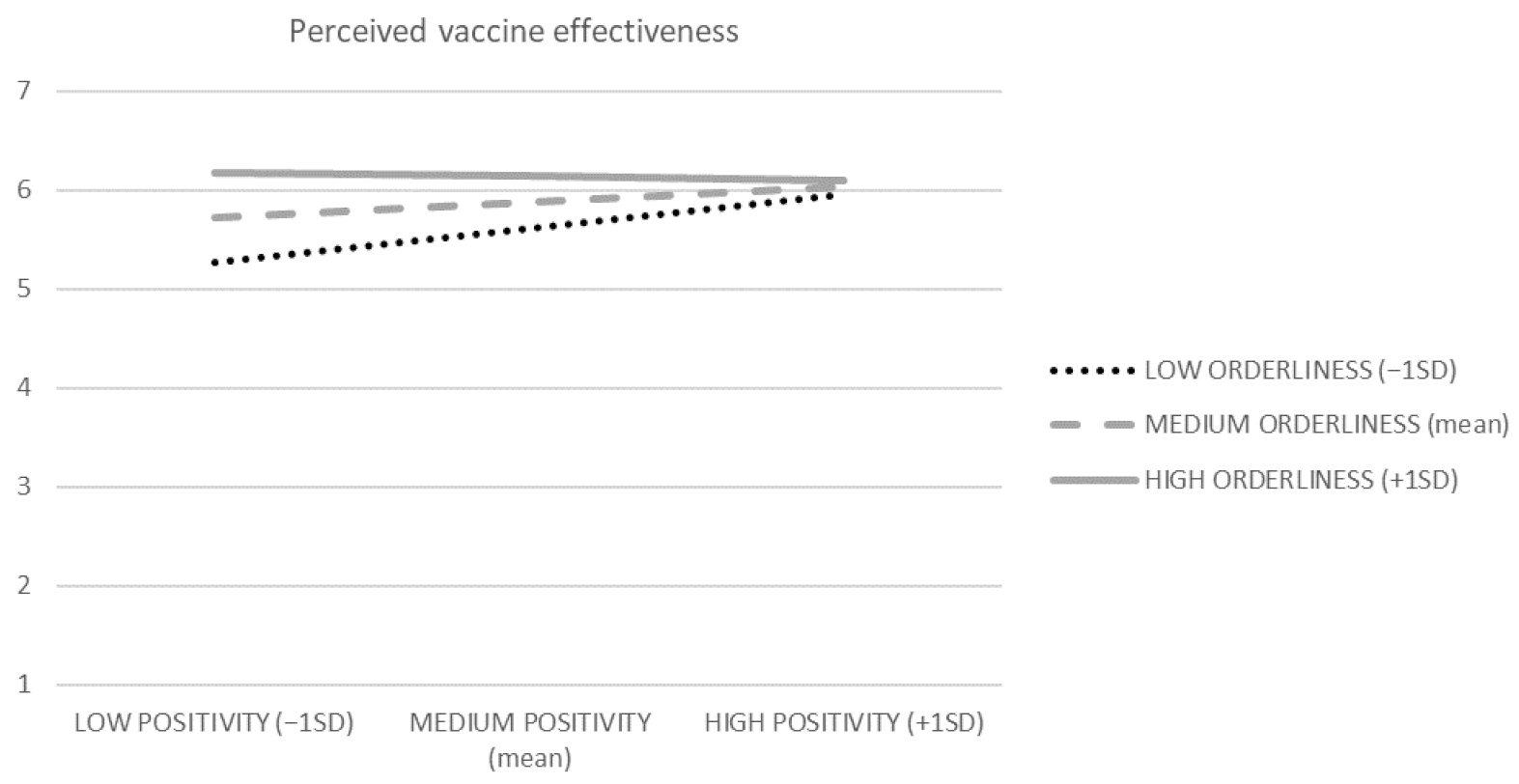
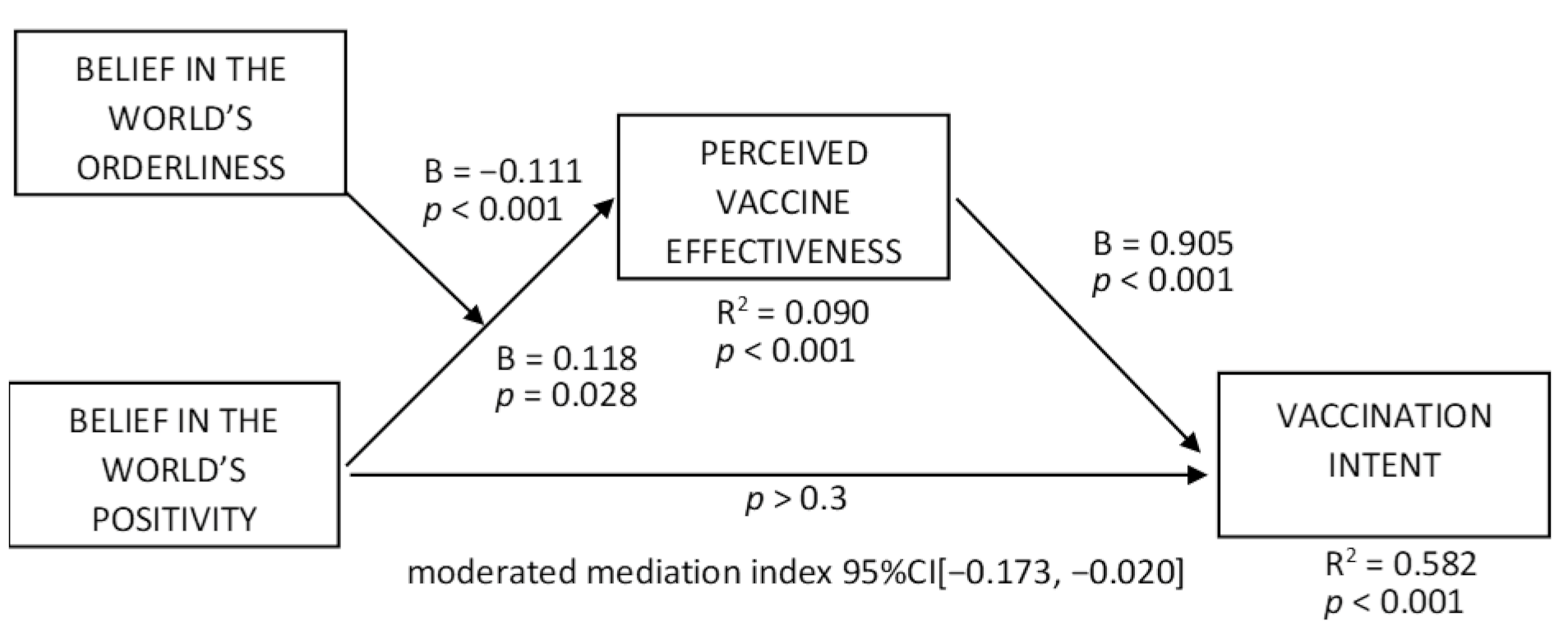
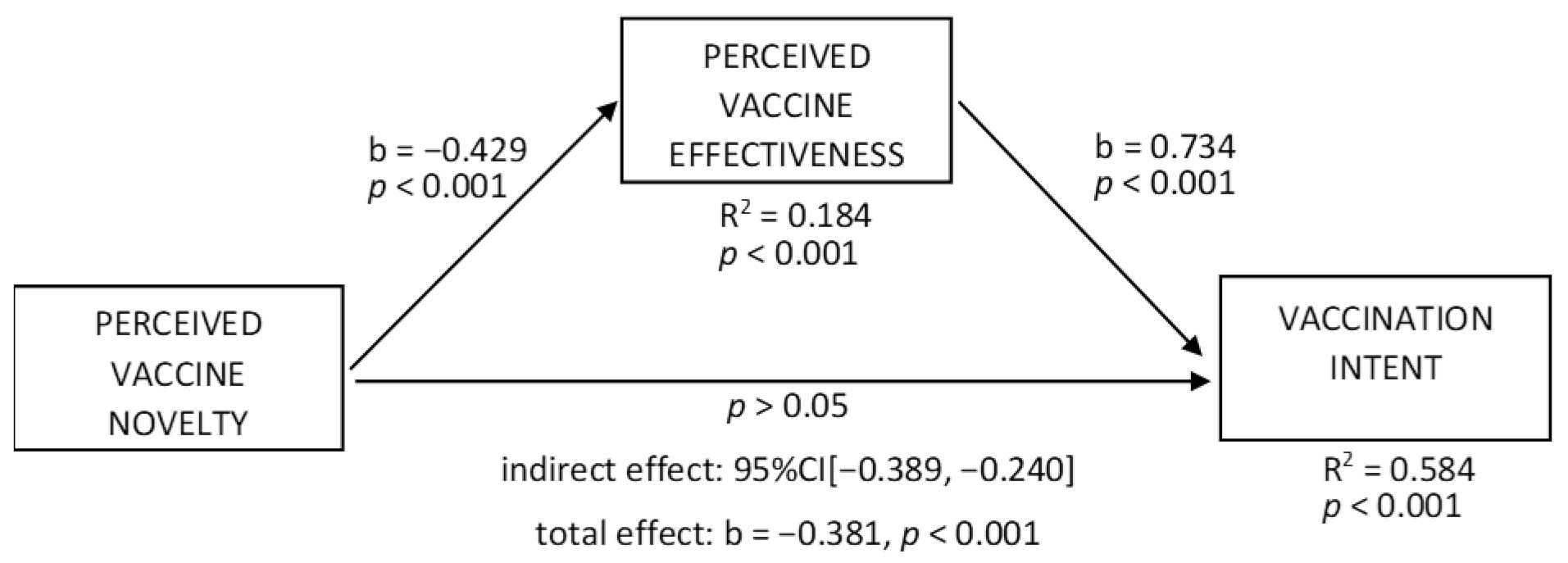
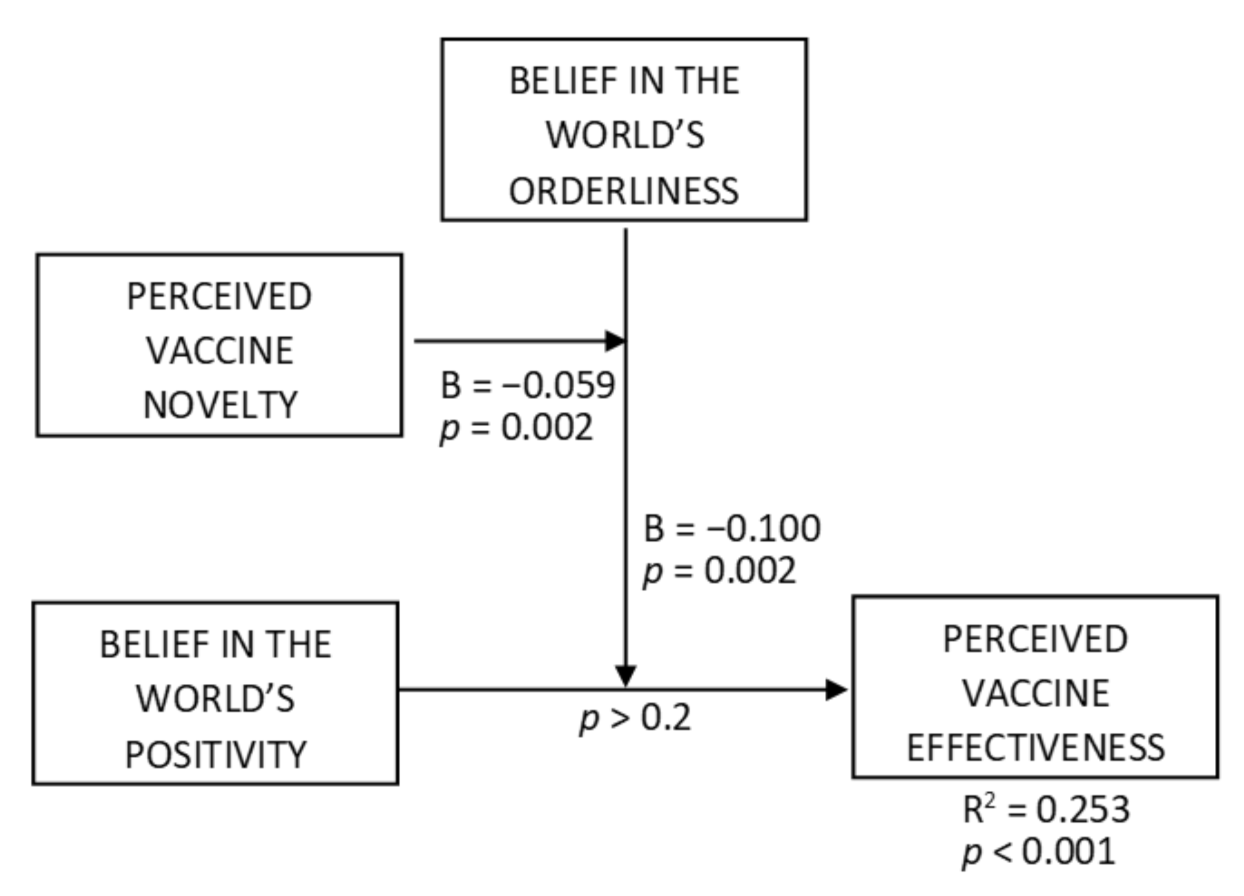

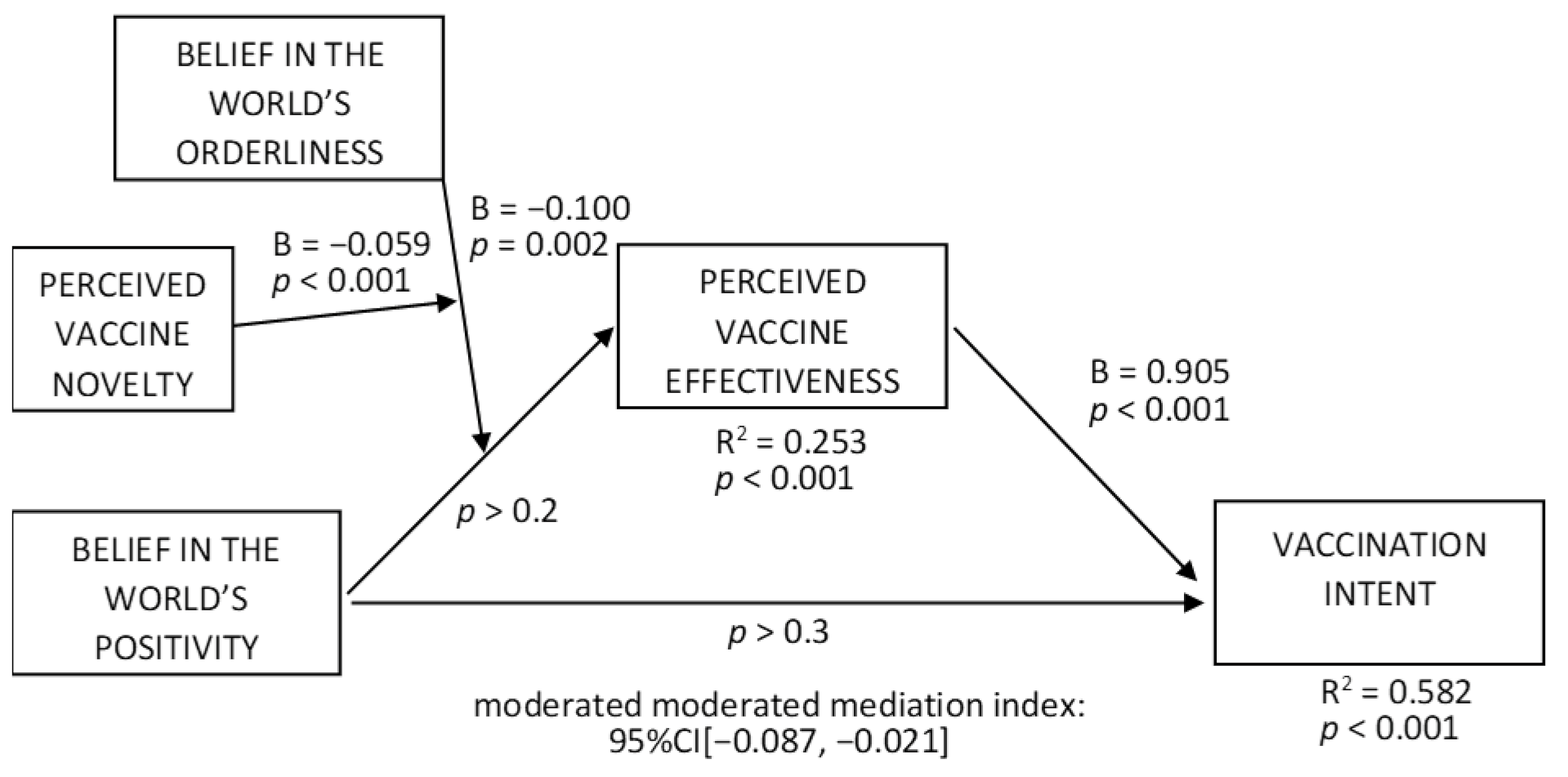
| Construct | Item | Reference | Reliability |
|---|---|---|---|
| Vaccination intent | I intend to get vaccinated for COVID-19. | Adapted from [3] | α = 0.915 |
| If the COVID-19 vaccine is free, I would like to get the vaccine. | |||
| Vaccination advocacy | I am willing to encourage others to get vaccinated. | Adapted from [5] | α = 0.933 |
| I am willing to provide arguments in favor of the vaccination. | |||
| I am willing to defend the vaccines if someone criticizes them. | |||
| Perceived vaccine effectiveness | COVID-19 vaccines are effective in protecting people from becoming seriously sick with COVID-19. | Adapted from [1] | α = 0.870 |
| If most people vaccinate against COVID-19, the pandemic will be kept under control or defeated. | Similar to [2] | ||
| Perceived vaccine novelty | When you think about COVID-19 vaccination, your impression is that things of that kind have been done for a long time. | Inspired by [61] | α = 0.730 |
| When you think about COVID-19 vaccination, your impression is that things of that kind are well known. | |||
| Belief in the world’s positivity | There will always be some people who will help us in a misfortune. | Adapted from [18,62] | α = 0.756 |
| People can be trusted. | |||
| The world is good even if we are not doing well. | |||
| People are good by nature. | |||
| Belief in the world’s orderliness | All that happens in the world is or can be explainable. | Adapted from [18,62] | α = 0.698 |
| The world is governed by general regularities, although it is sometimes difficult to see and understand them. | |||
| Looking from a deeper perspective, even the most incomprehensible paths of human life are explainable and have some sense. |
| Hypothesis Testing | Theoretical Implications/Contributions | Practical Implications (Examples) | |
|---|---|---|---|
| H1. The positive effect of belief in the world’s positivity on perceived vaccination effectiveness is weaker when consumer belief in the world’s orderliness is higher. SUPPORTED | Provides evidence for the negative orderliness × positivity interaction effect on vaccine attitudes [16], involving the perceived vaccine effectiveness as a mediator and other behavioral outcomes (i.e., the willingness to pay and vaccination advocacy). | Extends the literature on the consequences of optimism [20,25,26,27,36,37,38,39] into the domain of vaccine attitudes. | If a targeted consumer perceives vaccines as highly novel and the world as rather disordered, the vaccination advertisements can activate the idea of the world’s positivity. |
| H2. Belief in the world’s orderliness moderates (at the first stage) the mediation between belief in the world’s positivity and the vaccination-related behavioral outcomes through perceived vaccination effectiveness. Specifically, the indirect effects of positivity are weaker (less positive) for higher levels of orderliness. SUPPORTED | |||
| H5. The negative interaction effect of orderliness/positivity beliefs on perceived vaccine effectiveness (H1) is stronger for consumers perceiving vaccines as more novel. SUPPORTED | Provides further evidence for the negative orderliness × positivity interaction effect on vaccine attitudes [16], involving the perceived vaccine novelty as a moderator. | ||
| H6. Perceived vaccine novelty moderates the first-stage moderation effect of belief in the world’s orderliness on the mediation between belief in the world’s positivity and the vaccination-related behavioral outcomes (H2) through perceived vaccination effectiveness. Specifically, the moderation effects of orderliness are stronger (more negative) for higher levels of novelty. SUPPORTED | |||
| H3. Vaccines are perceived as less effective when consumers perceive vaccines as more novel. SUPPORTED | Extends previous studies on vaccination intent [21,22,23,24] by directly demonstrating the effects of perceived vaccine novelty on vaccination-related behavioral outcomes and demonstrating the mediating role of perceived vaccine effectiveness in those effects. | Vaccination advertisements can emphasize that vaccines are not novel or build positive associations with vaccine novelty. | |
| H4. Perceived vaccine effectiveness mediates the negative effect of perceived vaccine novelty on vaccination-related behavioral outcomes. SUPPORTED | |||
Publisher’s Note: MDPI stays neutral with regard to jurisdictional claims in published maps and institutional affiliations. |
© 2022 by the authors. Licensee MDPI, Basel, Switzerland. This article is an open access article distributed under the terms and conditions of the Creative Commons Attribution (CC BY) license (https://creativecommons.org/licenses/by/4.0/).
Share and Cite
Trzebiński, W.; Trzebiński, J. Do Optimists Like Vaccines? The Effect of Perceived Vaccine Novelty and Beliefs in the World’s Positivity and Orderliness on the Attitudes toward COVID-19 Vaccinations—The Case of European Young Adults. Vaccines 2022, 10, 379. https://doi.org/10.3390/vaccines10030379
Trzebiński W, Trzebiński J. Do Optimists Like Vaccines? The Effect of Perceived Vaccine Novelty and Beliefs in the World’s Positivity and Orderliness on the Attitudes toward COVID-19 Vaccinations—The Case of European Young Adults. Vaccines. 2022; 10(3):379. https://doi.org/10.3390/vaccines10030379
Chicago/Turabian StyleTrzebiński, Wojciech, and Jerzy Trzebiński. 2022. "Do Optimists Like Vaccines? The Effect of Perceived Vaccine Novelty and Beliefs in the World’s Positivity and Orderliness on the Attitudes toward COVID-19 Vaccinations—The Case of European Young Adults" Vaccines 10, no. 3: 379. https://doi.org/10.3390/vaccines10030379
APA StyleTrzebiński, W., & Trzebiński, J. (2022). Do Optimists Like Vaccines? The Effect of Perceived Vaccine Novelty and Beliefs in the World’s Positivity and Orderliness on the Attitudes toward COVID-19 Vaccinations—The Case of European Young Adults. Vaccines, 10(3), 379. https://doi.org/10.3390/vaccines10030379






